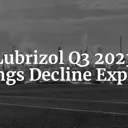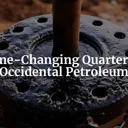Tags: Lubrizol / Earnings
This fanpage is not officially affiliated with Berkshire Hathaway: Disclaimer

This in-depth article examines Lubrizol's financial performance in 2022, with a focus on the factors that contributed to the company's revenue growth despite supply constraints and maintenance issues. It also offers insights into Lubrizol's history, strategic acquisitions, and global operations, before discussing the challenges posed by facility fires and outlining the company's prospects for 2023 and beyond.
Lubrizol is a Berkshire Hathaway subsidiary. The article is based on Berkshire Hathaway's annual report 2022.
Introduction
In 2022, Lubrizol Corporation , a specialty chemical and performance materials company based in Ohio, reported revenues of $6.7 billion, marking a 3.2% increase from the previous year. This growth, although significant, comes amid a challenging environment characterized by supply constraints for certain raw materials, unplanned maintenance activities, and adverse foreign currency translation effects. Despite these challenges, Lubrizol managed to navigate the economic landscape and increase its revenue, reflecting the resilience of the company's business model and its ability to adapt to changing market conditions.
As a shareholder of Berkshire Hathaway, it is crucial to understand the underlying factors that contributed to this revenue growth, as well as the broader historical context and economic forces shaping the specialty chemicals industry. In this article, we will delve into Lubrizol's business segments and applications, its evolution over the years, a detailed analysis of its 2022 revenue performance, supply chain constraints, and maintenance issues, along with the impact of facility fires on financial performance. By examining these aspects, we will provide a thorough and entertaining view of Lubrizol's current situation and future prospects, while highlighting important numerical facts and historical references.
Lubrizol's Business Segments and Applications
Lubrizol operates under two main business segments, Lubrizol Additives and Lubrizol Advanced Materials , each catering to diverse applications across multiple industries.
Lubrizol Additives
The Lubrizol Additives segment focuses on producing engine lubricant additives, driveline lubricant additives, and industrial specialties products. Engine lubricant additives are crucial for enhancing the performance and extending the life of engines, while driveline lubricant additives play a vital role in ensuring the smooth operation of transmission systems and other driveline components. Industrial specialties products are used in various applications, such as metalworking fluids and industrial lubricants, which provide protection against wear, corrosion, and other forms of damage in industrial machinery.
Lubrizol Advanced Materials
This segment encompasses engineered materials and life sciences products. Engineered materials include polymer solutions that enhance the performance and durability of consumer goods, such as coatings, adhesives, and sealants. Life sciences products comprise pharmaceutical ingredients, drug delivery systems, and beauty and personal care solutions, catering to the ever-growing demand for high-quality healthcare and personal care products.
With a broad range of applications, Lubrizol's products find use in a multitude of industries, from automotive and industrial machinery to healthcare and consumer goods. Lubrizol's additives are used in engine oils, transmission fluids, and metalworking fluids, ensuring the optimal performance and longevity of engines and machinery. In the personal care sector, Lubrizol's innovative formulations cater to beauty and personal care products, offering improved sensory experiences and enhanced product performance.
Lubrizol's commitment to technological leadership and its application of science capabilities, formulation know-how, and market expertise has enabled the company to develop solutions that address the ever-evolving demands of various industries. By continually improving the quality and value of its offerings, Lubrizol has managed to establish itself as a key player in the specialty chemicals and performance materials landscape.
Historical Context and Lubrizol's Evolution
Established in 1928, Lubrizol has navigated through nearly a century of economic and political changes, adapting and growing its business to meet the needs of an evolving world. Its early years were characterized by the development of lubricating oil additives for the burgeoning automotive industry, with the company's products contributing to improved fuel efficiency and engine performance.
Over the years, Lubrizol expanded its portfolio by venturing into the development of advanced materials, including polymer solutions for coatings, adhesives, and sealants, as well as life sciences products in the pharmaceutical and personal care sectors. The company's ability to adapt and innovate has been a driving force behind its continued success in an ever-changing global landscape.
Lubrizol's journey has also been shaped by strategic acquisitions and partnerships, helping the company to diversify its portfolio and broaden its global footprint. Notably, in 2011, Berkshire Hathaway acquired Lubrizol, providing the resources and support for the company to pursue long-term growth initiatives and further strengthen its market position.
Today, Lubrizol operates globally, with more than 100 offices, laboratories, production facilities, and warehouses spread across six continents. The company serves a diverse clientele, including major global and regional oil companies, as well as industrial and consumer products companies. Lubrizol's ability to evolve and adapt to shifting economic and political conditions has been instrumental in establishing the company as a leading player in the specialty chemicals and performance materials sector.
Revenue Analysis for 2022
Lubrizol's 2022 revenues reached $6.7 billion, representing a 3.2% increase compared to the previous year. This growth can be attributed to higher average selling prices, which were partially offset by lower sales volumes and adverse foreign currency translation effects resulting from a stronger U.S. Dollar. In this section, we will examine the factors that contributed to this revenue increase and draw comparisons with Lubrizol's financial performance in 2021.
Impact of Average Selling Prices, Lower Volumes, and Foreign Currency Translation Effects
The increase in average selling prices in 2022 was driven by escalating prices for raw materials, utilities, packaging, shipping, and freight costs. These higher costs necessitated the upward adjustment of Lubrizol's product prices, contributing to the revenue growth. However, this increase was tempered by lower sales volumes, which were the result of supply constraints for certain raw materials and unplanned maintenance activities throughout the year. These factors limited Lubrizol's production capabilities and, consequently, its sales volumes.
Additionally, the strengthening of the U.S. Dollar had unfavorable foreign currency translation effects on Lubrizol's revenues. As a globally operating company, Lubrizol is exposed to currency risks, and the appreciation of the U.S. Dollar against other currencies can negatively impact the company's reported revenues in U.S. Dollar terms.
Comparison to 2021 Revenue
In 2021, the global economy was still grappling with the lingering effects of the COVID-19 pandemic and the disruptions it caused across various industries. Lubrizol's revenue growth in 2022, despite the challenges posed by supply constraints and maintenance issues, highlights the company's resilience and ability to adapt to changing market conditions.
Pre-Tax Earnings Growth and Contribution of Insurance Recoveries
Lubrizol's pre-tax earnings in 2022 increased 48.6% compared to 2021, partly due to insurance recoveries of $242 million related to the fires at the Rouen, France facility in 2019 and the Rockton, Illinois facility in 2021. These recoveries bolstered the company's pre-tax earnings, offsetting some of the negative impacts from rising raw material costs, lower sales volumes, higher unplanned maintenance expenses, and unfavorable foreign currency translation effects experienced in 2022.
However, it is essential to note that the aggregate losses related to the Rockton, Illinois fire in 2022 amounted to $36 million, compared to $257 million in losses and asset impairment charges in 2021. The significant reduction in losses associated with the fire contributed to the substantial increase in Lubrizol's pre-tax earnings in 2022.
Supply Chain Constraints and Maintenance Issues
In 2022, Lubrizol's production capabilities and sales volumes were hampered by supply constraints for certain raw materials and unplanned maintenance activities at its facilities. This section will examine these challenges and their impact on Lubrizol's performance.
Effects of Supply Constraints on Raw Materials
The global supply chain disruptions caused by the COVID-19 pandemic, coupled with rising demand across various industries, led to supply constraints for essential raw materials, including oil feedstocks. These constraints limited Lubrizol's ability to procure the necessary raw materials, directly affecting its production capabilities and sales volumes.
Unplanned Plant Maintenance Activities
In addition to supply chain issues, Lubrizol also faced challenges due to unplanned maintenance activities at some of its plants. These activities, while necessary to ensure the safety and reliability of the facilities, resulted in temporary production downtimes that further constrained the company's output.
Winter Storms in 2021 and Their Effect on Earnings
In 2021, severe winter storms caused industry-wide temporary facility closures, negatively impacting earnings for that year. Lubrizol's ability to bounce back from these disruptions and deliver revenue growth in 2022, despite ongoing supply chain and maintenance challenges, speaks to the company's resilience and adaptability.
Factors Driving the Increase in Average Selling Prices
As previously mentioned, the increase in Lubrizol's average selling prices in 2022 was driven by several factors, which we will explore in more detail below.
Escalating Raw Material Prices
The rising prices of raw materials, particularly oil feedstocks, played a significant role in pushing up Lubrizol's average selling prices. The ongoing supply chain disruptions and increasing global demand have contributed to the upward pressure on raw material costs, forcing Lubrizol to adjust its product prices accordingly.
Rising Costs for Utilities, Packaging, Shipping, and Freight
In addition to raw material prices, the costs for utilities, packaging, shipping, and freight have also been on the rise. These cost escalations stem from a combination of factors, such as increased energy prices, higher labor costs, and the ongoing challenges in global logistics. Consequently, Lubrizol had to incorporate these additional costs into its product pricing, resulting in higher average selling prices.
Impact of Facility Fires on Financial Performance
Lubrizol's financial performance in recent years has been affected by fires at two of its facilities: the Rouen, France facility in 2019 and the Rockton, Illinois facility in 2021. In this section, we will examine the impact of these fires on the company's earnings and financial position.
Rouen, France Facility Fire in 2019
The fire at Lubrizol's Rouen facility in 2019 resulted in significant damages and losses. Insurance recoveries related to this incident amounted to $242 million in 2022, contributing positively to the company's pre-tax earnings. These recoveries not only helped offset some of the financial impact of the fire but also allowed Lubrizol to invest in facility repairs and improvements, ensuring the safety and operational excellence of the plant moving forward.
Rockton, Illinois Facility Fire in 2021
The fire at the Rockton, Illinois facility in 2021 also led to considerable losses and asset impairment charges. However, insurance recoveries for this incident, combined with a significant reduction in losses associated with the fire from $257 million in 2021 to $36 million in 2022, contributed to the substantial increase in Lubrizol's pre-tax earnings in 2022.
Outlook for 2023 and Beyond
Lubrizol expects supply chain and maintenance constraints to ease in 2023, allowing for increased production rates and sales volumes. The company is also investing significant capital to ensure the safety of its employees and the communities where it operates, while delivering on its commitments to operational excellence and cybersecurity.
As Lubrizol continues to leverage its technological leadership position and market expertise to develop innovative solutions for a diverse range of industries, the company is well-positioned for sustainable growth in the coming years. With a strong foundation and a history of adaptation and resilience, Lubrizol's future prospects appear promising for its shareholders, including those of Berkshire Hathaway.
In conclusion, we can highlight the following key takeaways from the article:
- Lubrizol's revenue growth in 2022, despite supply constraints and maintenance issues, demonstrates the company's resilience and adaptability in the face of challenges.
- The increase in average selling prices in 2022 reflects the rising costs of raw materials, utilities, packaging, shipping, and freight.
- Lubrizol's pre-tax earnings growth in 2022 was bolstered by insurance recoveries related to the Rouen and Rockton facility fires, as well as the reduction in losses associated with the Rockton fire.
- The company's commitment to innovation, operational excellence, and safety, coupled with its global presence and diverse product offerings, positions Lubrizol for continued success in the future.












